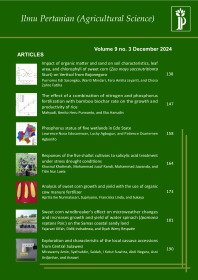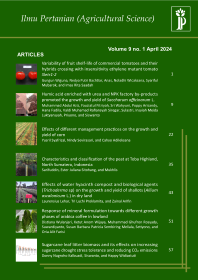
Utilization of Actinomycetes to increase phosphate availability at different soil moisture conditions in Andisols Namanteran, North Sumatera
M Reza Alfikri(1), T Sabrina(2*), Asmarlaili Sahar(3)
(1) Universitas Teknologi Nusantara
(2) Universitas Sumatera Utara
(3) Universitas Sumatera Utara
(*) Corresponding Author
Abstract
Keywords
Full Text:
PDFReferences
Ajidirman. (2010). Kajian Kandungan Mineral Alofan dan Fenomena Fiksasi Fosfor Pada Andisols. J.Hidrolitan, 1(2), pp. 15−20.
Alfikri, M.R., Sabrina, T., and Sahar, A. (2019). Isolation, Purification and Potential Test of Actinomycetes in Increasing Phosphate Availability. The 3rd International Conference Community Research and Service Engagements, IC2RSE 2019, 4th December 2019, North Sumatra, Indonesia.
Alori, E.T., Glick, B.R., and Babalola, O.O. (2017). Microbial phosphorus solubilization and its potential for use in sustainable agriculture. Front Microbiol, 8, 971.
Bhatti, A. A., Shamsul, H., and Rouf, A. B. (2017). Actinomycetes benefaction role in soil and plant health. Jurnal Microbial Pathogenesis, 111, pp. 458−467.
Biglari, N., Hasnuri, M. H., and Javid, A. (2016). The Ability of Streptomyces spp. Isolatd from Iranian Soil to Solubilize Rock Phosphate. Advances in Bioscience & Clinical Medicine, 4(3), 15−25.
Havlin, J.L., Beaton, J.D., Tisdale, S.L., and Nelson, W.L. (2013). Soil fertility and fertilizers: An introduction to nutrient management. 8th ed. Upper Saddle River, NJ: Pearson, pp. 528.
Javed, Z., Gyan, D. T., Mansi, M., and Kavya, D. (2021). Actinomycetes – The microbial machinery for the organic-cycling, plant growth, and sustakantinable soil health. Biocatalysis and Agricultural Biotechnology, 31, 101893.
Kavitha, P. G., and Doble, M. (2014). Production and characterization of antibacterial compounds from Streptomyces species under optimized conditions. International Journal of Pharmacy and Pharmaceutical Sciences, 6(4), pp 24−430.
Li, W., Guo, L., Li, Y., and Liu, Y. (2021). Mechanisms of phosphorus solubilization by soil microorganisms and plants. Journal of Soils and Sediments, 21(3), pp. 1263−1277.
Marbun, S., Sembiring, M., and Bintang. (2015). Aplikasi Mikroba Pelarut Fosfat dan Bahan Organik untuk Meningkatkan Serapan P dan Pertumbuhan Kentang Pada Andisol Terdampak Erupsi Gunung Sinabung. Jurnal Agroekoteknologi, 4(1), 1651−1658.
Siddiqui, Z. A., and Akhtar, M. S. (2017). Plant growth promoting rhizobacteria as biofertilizers. Singapore: Springer.
Susilowati, L.E and Syekhfani, S. (2014). Characterization of phosphate solubilizing bacteria isolatd from Pb contaminated soils and their potential for dissolving tricalcium phosphate. Journal of Degraded and Mining Lands Management, 1(2), pp. 57−62.
Wahbi, S., Bonhomme, M., Ainouche, A., and Jemo, M. (2016) Managing the soil mycorrhizal infectivity to improve the agronomic efficiency of key processes from natural ecosystems integrated in agricultural management systems. In: Hakeem, K.R., Akhtar, M.S., and Abdullah, S.N.A., Plant, Soil and Microbes. Springer International Publishing, pp. 17−27.
Widawati, S., Arif, N., and I Made, S. (2008). Aktivitas Pelarutan Fosfat oleh Actinomycetes yang Diisolasi dari Waigeo, Kepulauan Raja Ampat, Papua Barat. Jurnal Biodiversitas, 9(2), pp. 87−90.
Zuo, Y. Y., Guo, Y. N., and Xue, Y. F. (2022). Organic acid exudation by plant roots affects soil nutrient availability and microbial community composition in an agroforestry system. Applied Soil Ecology, 170, 104173.
Article Metrics
Refbacks
Ilmu Pertanian (Agricultural Science) ISSN 0126-4214 (print), ISSN 2527-7162 (online) is published by Faculty of Agriculture Universitas Gadjah Mada collaboration with Perhimpunan Sarjana Pertanian Indonesia (PISPI) and licensed under a Creative Commons Attribution-ShareAlike 4.0 International License.














